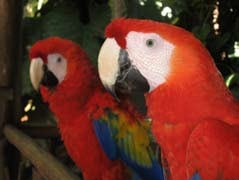The Scarlet Macaw, one of the most beautiful Macaws, lives high in the trees of lowland deciduous or tropical evergreen forests gracing forest canopies from Mexico to central South America. This brilliantly colored macaw is the only one found on the Pacific side of Costa Rica, and it rarely flies on the Caribbean side, where the Great Green Macaw lives.
 Macaws are the largest parrots in the Americas, and the Scarlet Macaw is distinct both in color and shape. It's bold colors include bright red, blue and yellow. It has a large powerful bill for cracking tough seed coats and nuts. Both sexes of these birds have adult plumage from a young age. The scarlet macaw noisily flies high over the canopy and their travels may range far both daily and seasonally. Their loud, resonant, boisterous calls can often be heard as they fly, but they are usually quiet while feeding. Pairs, trios, or small family groups are often seen, but these may sometimes merge into flocks of 25 or even 50 individuals at large roosts in tall trees or mangroves.
Macaws are the largest parrots in the Americas, and the Scarlet Macaw is distinct both in color and shape. It's bold colors include bright red, blue and yellow. It has a large powerful bill for cracking tough seed coats and nuts. Both sexes of these birds have adult plumage from a young age. The scarlet macaw noisily flies high over the canopy and their travels may range far both daily and seasonally. Their loud, resonant, boisterous calls can often be heard as they fly, but they are usually quiet while feeding. Pairs, trios, or small family groups are often seen, but these may sometimes merge into flocks of 25 or even 50 individuals at large roosts in tall trees or mangroves.
The Scarlet Macaw nests in large holes in tall living or dead trees; they do not dig these holes, but rely on finding cavities that are high off the ground and have vertical entrances. Finding enough of such trees can be a limiting factor for these birds to maintain populations in an area, especially because some bee species occupy the same kind of tree cavity. A macaw pair will lay 1-2 eggs per season in such a nest and raise them together. These macaws are serially monogamous, but they may change mates after several seasons.
In 1900, these parrots could still be readily seen in forests throughout Costa Rica; by 1950, however, due to habitat destruction, they were absent from the Caribbean slope except in the Northwest. They have also suffered from the pet trade; fortunately, today they are protected in every country in which they live. However, in Costa Rica, their populations still have been reduced by the destruction of their habitat. They are now constrained to the forests of the upper Golfo de Nicoya and the forests ofthe Osa Peninsula. We have quite a few mated pair in and around Ojochal and our developments. They are amazing to see in flight.
Their favorite food, at least in Costa Rica, is the almond sized and shaped seed of Terminalia Catappa tree. They can be rapid foragers. A flock of 10 birds can carpet the ground with three hundred of these fruits in a single hour as they look for the seeds.
Skutch, Alexander F. and F. Gary Stiles. A Guide to the Birds of Costa Rica.
Utica: Cornell University Press,1989.
Stiles, F.G. in: Janzen, Daniel H. Costa Rican Natural History. Chicago:
University of Chicago Press, 1983.


